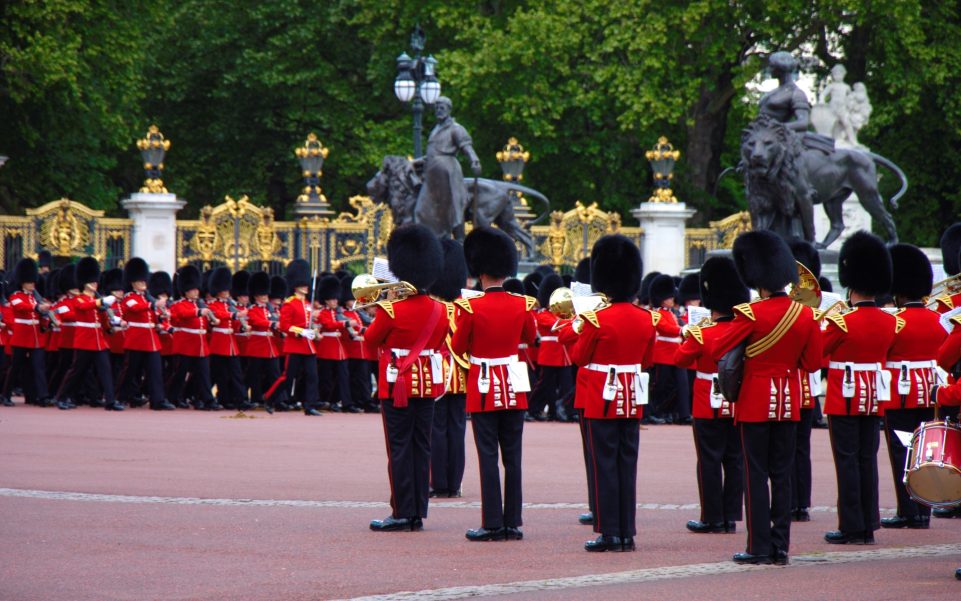British Royal Guard: How Easy Is It To Become One

The Royal Guard has become a true symbol of the UK. It is hard to imagine London without its lean guardsmen in red coats and black fur hats. Royal Guard soldiers can be seen not only guarding Buckingham Palace, whether in postcards, photos, and on the pages of books and films, but they are England’s Guards – a significant national emblem. Many tourists who come to London can’t resist taking a photo with these soldiers.
There is a misconception that the Royal Guards are there just for show. The history of the Guards goes back to the 17th century. It’s no easy task to become a guard, let alone serve as one.
Historical Background
Royal Guard soldiers have always been part of the British Army. Their main purpose was to guard the monarch’s family and royal residences.
Separate groups of soldiers have protected British monarchs since the reign of Henry VII, who saw the need to restore royal authority after the Wars of the Roses (1455-1487).
However, the history of the modern British Royal Guards began much later, in the 17th century, when the first Regiments of the Guards were formed. This occurred during the Stuart Restoration, a period when royal power was restored and safeguarding the monarch’s family became more significant.
The first Changing of the Guard ceremony took place at Whitehall Palace in the mid-1660s. In 1689, the Royal Court moved to St James’s Palace and the Guard of Honour followed. Buckingham Palace started hosting the ceremony in 1837, when Queen Victoria made it her official residence. The King’s or Queen’s Guard (depending on the reigning monarch) is organised by the British Army’s Household Division.
What Do Guards Do?
We might think that the historical role of the Household Division has been lost and today the guards play only a ceremonial role. But this is far from being true. A guard is required to be militarily trained and can be sent to serve in a hot spot if needed. The royal soldier’s duties also include patrolling the grounds of a royal palace and taking part in disaster relief and humanitarian missions.
Nobody knows the exact number of serving guards; it’s probably a state secret. However, it’s not a secret that the Household Division consists of two Household Cavalry regiments and 5 regiments of foot guards. The Coldstream Guards, the Grenadier Guards, and the Scots Guards were formed in the 17th and 18th centuries while the Irish and Welsh Guards are relatively young. The infantrymen are responsible for guarding Buckingham Palace and St James’s Palace and are on duty 24 hours a day. The Horse Guards are on duty during daylight hours only.
Sentry duty is not only important but also extremely challenging. The service is strictly regulated by a set of rules, and they have to follow a certain morning routine.
Here are the rules:
- Guards armed with rifles and bayonets will have two hours on sentry duty and four hours off. Every 10 minutes they can take 15 steps across the area of the post and march back.
- The Mounted Guards have no weapons other than their broadswords and they rotate every hour, as a horse cannot remain motionless for long.
- The Guards have to stand still for hours and pay no attention to the weather conditions or external factors such as annoying tourists.
- While on guard duty, soldiers are forbidden to talk to anyone.
- On post, guards often faint in their warm hats under the scorching sun. It may come as a surprise that there are even instructions on how to faint. If a guard faints, he must fall face down, and his comrades-in-arms are not allowed to help him. Specially trained men will carry the unconscious soldier away without disturbing the ceremony.
The slightest breach of these rules, such as a smile, is punishable by a fine or a severe reprimand.
Uniform
The Guards wear a distinctive uniform — bright British red coats and tall black bearskin hats. Such uniforms were not accidental but practical. Coats used to be painted red because it was the most difficult colour to see. From a distance, the coats merged into one bright spot so an enemy couldn’t tell the number of attackers. Tall hats made a soldier look taller and more intimidating to the enemy. These hats also protected against bullets, as the enemy would hit the hat when aiming at the head.
By the way, it is very tough to wear a bearskin hat as it can weigh up to 4kg and be almost half a metre tall. The Guards wear a bearskin strap under their lips, which may seem strange. However, if such a hat was fastened under the chin, it could easily break a soldier’s neck if he fell backwards.
Distinguishing between guards of different regiments is not so easy. The difference will be in tiny, almost invisible details that only the most attentive and keen-eyed viewers or history buffs will be able to spot. For example, Grenadier Guards’ coats have buttons sewn in a single row, Coldstream Guards’ coats have them in pairs, Scottish Guards’ coats have three buttons in a row, Irish Guards’ coats have four and the Welsh Guards’ coats have five. The main difference between the hats is where to place and how to colour the plume:
- The Grenadier Guards wear hats with small white plumes on the left.
- The Coldstream Guards have a red plume on the right.
- The Scots Guards don’t wear a plume at all.
- The Irish Guards wear a blue plume on the right.
- The Welsh Guards have a white-green plume on the left.
About the Guards
Any British citizen between the ages of 16 and 35.5 can join the Royal Guard. But it is not that simple, as English guards have to pass a strict selection. The guards-to-be must be at least 178 cm tall, in good physical shape, have stamina and be psychologically stable. Tourists often try to make a Guard on duty laugh or get angry, but he must always stand still. Recently, the number of incidents with tourists has increased, so the guards are not being posted among the public.
By the way, you can join the Royal Guard even if you have no experience in the military. In this case, recruits undergo six months to a year of basic military training. They are taught how to shoot, how to read topographic maps and how to administer first aid. Moreover, they will undergo rigorous physical training.
All guards live in barracks or, if they have a family, in military family homes. Soldiers are provided with spacious double rooms with comfortable beds and TVs, so conditions are quite good. One of the most important privileges of the guards is an annual meeting with the Royal Family. For a special monarch’s reception, any soldier can bring his mother, wife or fiancée.
Ceremonial events
The Changing of the Guard and the monarch’s birthday are the most important ceremonies in which the soldiers of the Royal Guard take part. These events are open to all tourists.
Changing of the Guard
The ceremonial Changing of the Guard takes place in front of Buckingham Palace every day in the summer and every other day in the winter. The schedule can be found on the official website. The ceremony lasts 45 minutes, during which time the guards march out onto the parade ground with precision and coherence, taking over from their comrades. The Changing is always accompanied by the famous Guards Band, which sometimes plays unexpected compositions such as Beatles hits or a soundtrack from Game of Thrones.
The Monarch’s Birthday
The Monarch’s birthday is celebrated in June, regardless of the actual date of his or her birth. This is the day of the Changing of the Guard when the ensign is paraded. The ensign is carried according to the order: one year it is given to the Grenadier Guards, another year to the Coldstream Guards, a third year to the Scots Guards, and so on. Such a parade can last several hours, and since it is often hot in the summer, the Monarch’s birthdays are marked by a sequence of fainting guards.
Things to Know About the Royal Guard
- You can tell if the monarch is at home by the number of guards on duty If there are four soldiers at the gates of Buckingham Palace, it means the King is at home; if there are only two, he is away.
- Even during the Second World War, during the bombing of London, the Royal Guard remained at their posts. In those days they stood sentry in special armoured boxes.
- The Sovereign’s official residence is still St James’s; the Guard Commander is based there, as are the regiment’s colours.
- You do not have to be English to join the Guard. Other nationalities, such as those from India, Pakistan and Africa, are also represented in the Royal Guard.
- Animal rights activists have for many years objected to the use of natural fur in the guards hats, demanding that only synthetic materials be used. The British Government has tried to make concessions, even ordering several samples designed by Stella McCartney. Unfortunately, the synthetic hats did not stand up to the weather.
FAQs about the Royal Guard
How much do royal guards make?
There is no compulsory military service in the country, so the guards serve under contract. They are paid a modest salary by UK standards, starting at £18,687 a year, depending on the length of service. But soldiers have a prestigious and respected job.
What kind of fur are the guards' hats made from?
Guards’ hats are made from the natural fur of Canadian grizzly bears. Officers’ hats are made from a male bear’s fur, making the hats shinier, while NCOs’ and privates’ hats are made from a female bear’s fur.
Are royal guards allowed to talk?
The King’s Guard (or the Queen’s Guard if the reigning monarch is female) respect the rules that strictly forbid them to talk while on duty. However, the guards may shout a few menacing warnings in situations where strangers are causing obstacles or blocking the guards’ path, such as:
- Do not touch the King’s Guard!
- Make way for the King’s Guard!




